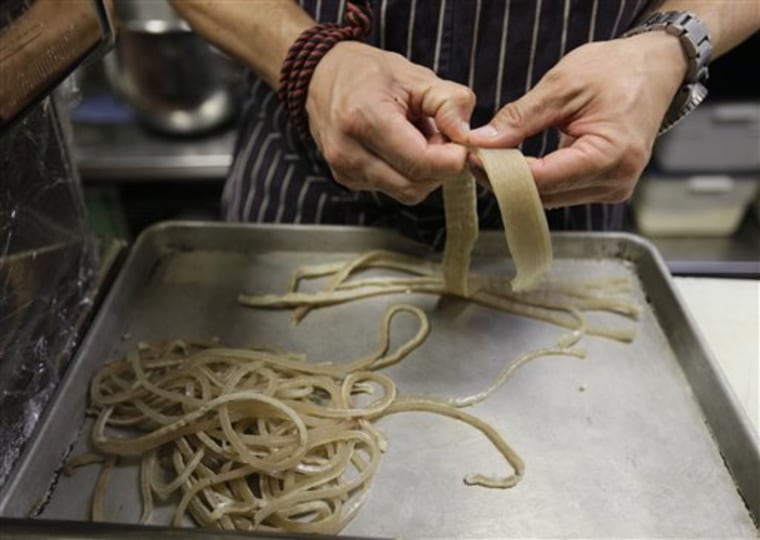San Francisco chef Chris Cosentino isn't much of a football fan. But that doesn't mean he doesn't know how to toss the pigskin around the gridiron. Or the frying pan.
We're talking hide of the hog, of course, that often-neglected part of the pig that is winning new appreciation as chefs tune in to its lush, unctuous properties.
"We're starting to see it become the focus," says Cosentino, chef at Incanto restaurant in San Francisco and a champion of so-called nose-to-tail eating. "Pigskin is becoming the highlighted item in the dish now, whereas before it was more of an additional component to the dish. It has its own uniqueness. It has its own texture, its own flavor."
Among his specialties is ciccioli, a kind of sausage made by braising scraps of lean meat with fat and skin and seasoning the mixture with garlic and rosemary, and chicharons, pieces of pork rind that have been seasoned and deep-fried.
Perhaps the most interesting recipe is the pigskin pasta, in which marinated skin is slowly braised so it's tender, but not too soft, then then chilled. After that, excess fat is scraped off and the skin is cranked through a pasta cutter to produce "spaghetti."
Cosentino first encountered the pigskin pasta, served with a marinara sauce, at the Joe Beef restaurant in Montreal and was "bummed out that I hadn't figured it out first," he says with a laugh. Fortunately, chef Fred Morin was willing to share. He has served the pigskin pasta with porcini and truffles, a natural pairing since pigs hunt truffles, as well as with clams and cherry tomatoes.

In Texas, chef Tim Love of the Lonesome Dove Western Bistro in Fort Worth has his own take on pigskin.
Unlike Cosentino, Love is a football fan, the Dallas Cowboys to be specific, and has cooked for the players. Sundays mean roast meat and tailgating, which often includes the PLT — crispy pigskin, lettuce and tomato — a sandwich he broke out at a tailgate party one day "and everybody went crazy."
An easy snack is to take a bag of fried hot and spicy pork skins and top them with red onion, creme fraiche and some caviar. Zippy and creamy "it's a great hors d'oeuvre," Love says. He also makes pigskin nachos, using pulled pork on top of crunchy pigskins with a few pickled chilies.
Boston chef Ken Oringer has divided loyalties when it comes to football. As owner of six Beantown restaurants including Clio, Uni and Toro, his sympathies naturally lie with the New England Patriots, some of whom often visit his restaurants. But as a native of New Jersey he has to root for the J-E-T-S, too.
Pigskin, on the other hand, inspires no such reservations.
At Clio he fries pigskin and uses it as a vessel for "chowder" with oyster emulsion, freeze-dried corn and crispy slivers of potato. At La Verdad, his taqueria, he braises pigskin in spicy salsa verde for tacos and stuffs it into corn tortillas topped with radishes, cilantro, pickled onions and jalapeno.
"I love cooking with pig skin. It's an ingredient used in so many cuisines, from Southeast Asian to Spain to Brazil, and I love seeing how different cultures use it," says Love. "It's interesting to see how chefs turn this rustic, almost peasant, ingredient into an elevated and composed dish. It's something that is so rooted in the food of grandmothers, and has recently been embraced by chefs and diners more than ever."
There is, he says, "nothing like that slippery, voluptuous mouth feel of pigskin, so gelatinous and tender."
Incanto's Cosentino, an authority on offal whose website, Offal Good, promotes eating animal parts that have fallen out of favor, also points out that the new emphasis on pigskin is reviving old customs.
"There's really cool old dishes of skin and beans and skin and braised greens. Nobody's reinvented the wheel